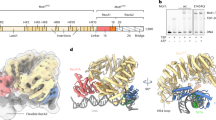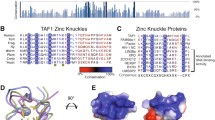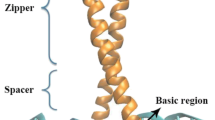Abstract
Gene expression generally initiates from recognition of TATA-box binding protein (TBP) to the minor groove of DNA of TATA box sequence where the DNA structure is significantly different from B-DNA. We have carried out molecular dynamics simulation studies of TBP–DNA system to understand how the DNA structure alters for efficient binding. We observed rigid nature of the protein while the DNA of TATA box sequence has an inherent flexibility in terms of bending and minor groove widening. The bending analysis of the free DNA and the TBP bound DNA systems indicate presence of some similar structures. Principal coordinate ordination analysis also indicates some structural features of the protein bound and free DNA are similar. Thus we suggest that the DNA of TATA box sequence regularly oscillates between several alternate structures and the one suitable for TBP binding is induced further by the protein for proper complex formation.






Similar content being viewed by others
References
Deremble C, Lavery R (2005) Macromollecullar recognition. Curr Opin Struct Biol 15(2):171–175. doi:10.1016/j.sbi.2005.01.018
Sarai A, Kono H (2005) Protein–DNA recognition patterns and predictions. Annu Rev Biophys Biomol Struct 34:379–398. doi:10.1146/annurev.biophys.34.040202.144537
Rhodes D, Schwabe JWR, Chapman L, Fairall L (1996) Towards an understanding of protein–DNA recognition. Philos Trans R Soc Lond Ser B 351(1339):501–509. doi:10.1098/rstb.1996.0048
Paillard G, Lavery R (2004) Analyzing protein–DNA recognition mechanisms. Structure 12(1):113–122. doi:10.1016/j.str.2003.11.022
Fischer E (1894) Einfluss der configuration auf die wirkung der enzyme. Ber Dtsch Chem Ges 27:9
Gromiha MM, Siebers JG, Selvaraj S, Kono H, Sarai A (2004) Intermolecular and intramolecular readout mechanisms in protein–DNA recognition. J Mol Biol 337(2):285–294. doi:10.1016/j.jmb.2004.01.033
Gromiha MM, Slebcrs JG, Selvaraj S, Kono H, Sarai A (2005) Role of inter and intramolecular interactions in protein–DNA recognition. Gene 364:108–113. doi:10.1016/j.gene.2005.07.022
Koshland DE (1958) Application of a theory of enzyme specificity to protein synthesis. Proc Natl Acad Sci USA 44(2):98–104. doi:10.1073/pnas.44.2.98
Ma BY, Kumar S, Tsai CJ, Nussinov R (1999) Folding funnels and binding mechanisms. Protein Eng 12(9):713–720. doi:10.1093/protein/12.9.713
Troyer JM, Cohen FE (1995) Protein conformational landscapes—energy minimization and clustering of a long molecular-dynamics trajectory. Proteins Struct Funct Genet 23(1):97–110. doi:10.1002/prot.340230111
Frauenfelder H, Sligar SG, Wolynes PG (1991) The energy landscapes and motions of proteins. Science 254(5038):1598–1603. doi:10.1126/science.1749933
Boehr DD, Nussinov R, Wright PE (2009) The role of dynamic conformational ensembles in biomolecular recognition. Nat Chem Biol 5(11):789–796. doi:10.1038/nchembio1209-954d
Kumar S, Ma BY, Tsai CJ, Sinha N, Nussinov R (2000) Folding and binding cascades: dynamic landscapes and population shifts. Protein Sci 9(1):10–19. doi:10.1110/ps.9.1.10
Grunberg R, Leckner J, Nilges M (2004) Complementarity of structure ensembles in protein–protein binding. Structure 12(12):2125–2136. doi:10.1016/j.str.2004.09.014
Wlodarski T, Zagrovic B (2009) Conformational selection and induced fit mechanism underlie specificity in noncovalent interactions with ubiquitin. Proc Natl Acad Sci USA 106(46):19346–19351. doi:10.1073/pnas.0906966106
Csermely P, Palotai R, Nussinov R (2010) Induced fit, conformational selection and independent dynamic segments: an extended view of binding events. Trends Biochem Sci 35(10):539–546. doi:10.1016/j.tibs.2010.04.009
Klug A, Jack A, Viswamitra MA, Kennard O, Shakked Z, Steitz TA (1979) Hypothesis on a specific sequence-dependent conformation of dna and its relation to the binding of the lac-repressor protein. J Mol Biol 131(4):669–680. doi:10.1016/0022-2836(79)90196-7
Dixit SB, Andrews DQ, Beveridge DL (2005) Induced fit and the entropy of structural adaptation in the complexation of CAP and lambda-repressor with cognate DNA sequences. Biophys J 88(5):3147–3157. doi:10.1529/biophysj.104.053843
Dragan AI, Read CM, Makeyeva EN, Milgotina EI, Churchill MEA, Crane-Robinson C, Privalov PL (2004) DNA binding and bending by HMG boxes: energetic determinants of specificity. J Mol Biol 343(2):371–393. doi:10.1016/j.jmb.2004.08.035
Crothers DM (1998) DNA curvature and deformation in protein–DNA complexes: a step in the right direction. Proc Natl Acad Sci USA 95(26):15163–15165. doi:10.1073/pnas.95.26.15163
Davis NA, Majee SS, Kahn JD (1999) TATA box DNA deformation with and without the TATA box-binding protein. J Mol Biol 291(2):249–265. doi:10.1006/jmbi.1999.2947
Cherstvy AG (2009) Positively Charged Residues in DNA-binding domains of structural proteins follow sequence-specific positions of DNA phosphate groups. J Phys Chem B 113(13):4242–4247. doi:10.1021/jp810009s
Garcia-Perez M, Pinto M, Subirana JA (2003) Nonsequence-specific arginine interactions in the nucleosome core particle. Biopolymers 69(4):432–439. doi:10.1002/bip.10389
Werner MH (1996) Intercalation, DNA kinking, and the control of transcription. Science 271(5250):778–784. doi:10.1126/science.271.5250.778
Privalov PL, Dragan AI, Crane-Robinson C (2009) The cost of DNA bending. Trends Biochem Sci 34(9):464–470. doi:10.1016/j.tibs.2009.05.005
Kim YC, Geiger JH, Hahn S, Sigler PB (1993) Crystal-structure of a yeast TBP TATA-box complex. Nature 365(6446):512–520. doi:10.1038/365512a0
Nikolov DB, Burley SK (1994) 2.1-Angstrom resolution refined structure of a TATA box-binding protein (TBP). Nat Struct Biol 1(9):621–637. doi:10.1038/nsb0994-621
Osheagreenfield A, Smale ST (1992) Roles of TATA and initiator elements in determining the start site location and direction of rna polymerase-II transcription. J Biol Chem 267(2):1391–1402
Singer VL, Wobbe CR, Struhl K (1990) A wide variety of DNA-sequences can functionally replace a yeast TATA element for transcriptional activation. Genes Dev 4(4):636–645. doi:10.1101/gad.4.4.636
Wang Y, Stumph WE (1995) RNA-polymerase II/III transcription specificity determined by TATA box orientation. Proc Natl Acad Sci USA 92(19):8606–8610. doi:10.1073/pnas.92.19.8606
Wobbe CR, Struhl K (1990) Yeast and human TATA-binding proteins have nearly identical DNA-sequence requirements for transcription invitro. Mol Cell Biol 10(8):3859–3867. doi:10.1128/MCB.10.8.3859
Kim JL, Nikolov DB, Burley SK (1993) Co-crystal structure of TBP recognizing the minor-groove of a TATA element. Nature 365(6446):520–527. doi:10.1038/365520a0
Kim JL, Burley SK (1994) 1.9-Angstrom resolution refined structure of TBP recognizing the minor-groove of TATAAAAG. Nat Struct Biol 1(9):638–653. doi:10.1038/nsb0994-638
Nikolov DB, Chen H, Halay ED, Hoffmann A, Roeder RG, Burley SK (1996) Crystal structure of a human TATA box-binding protein/TATA element complex. Proc Natl Acad Sci USA 93(10):4862–4867. doi:10.1073/pnas.93.10.4862
Wu J, Parkhurst KM, Powell RM, Brenowitz M, Parkhurst LJ (2001) DNA bends in TATA-binding protein center dot TATA complexes in solution are DNA sequence-dependent. J Biol Chem 276(18):14614–14622. doi:10.1074/jbc.M004402200
Wu J, Parkhurst KM, Powell RM, Parkhurst LJ (2001) DNA sequence-dependent differences in TATA-binding protein-induced DNA bending in solution are highly sensitive to osmolytes. J Biol Chem 276(18):14623–14627. doi:10.1074/jbc.M004401200
Geggier S, Vologodskii A (2010) Sequence dependence of DNA bending rigidity. Proc Natl Acad Sci USA 107(35):15421–15426. doi:10.1073/pnas.1004809107
Du Q, Kotlyar A, Vologodskii A (2008) Kinking the double helix by bending deformation. Nucleic Acids Res 36(4):1120–1128. doi:10.1093/nar/gkm1125
Vafabakhsh R, Ha T (2012) Extreme bendability of DNA less than 100 base pairs long revealed by single-molecule cyclization. Science 337(6098):1097–1101. doi:10.1126/science.1224139
Kannan S, Kohlhoff K, Zacharias M (2006) B-DNA under stress: over- and untwisting of DNA during molecular dynamics simulations. Biophys J 91(8):2956–2965. doi:10.1529/biophysj.106.087163
Starr DB, Hoopes BC, Hawley DK (1995) DNA bending ss an important component of site-specific recognition by the TATA-binding protein. J Mol Biol 250(4):434–446. doi:10.1006/jmbi.1995.0388
Qian XL, Strahs D, Schlick T (2001) Dynamic simulations of 13 TATA variants refine kinetic hypotheses of sequence/activity relationships. J Mol Biol 308(4):681–703. doi:10.1006/jmbi.2001.4617
Hancock SP, Ghane T, Cascio D, Rohs R, Di Felice R, Johnson RC (2013) Control of DNA minor groove width and Fis protein binding by the purine 2-amino group. Nucleic Acids Res. doi:10.1093/nar/gkt357
Samanta S, Chakrabarti J, Bhattacharyya D (2010) Changes in thermodynamic properties of DNA base pairs in protein–DNA recognition. J Biomol Struct Dyn 27(4):429–442. doi:10.1080/07391102.2010.10507328
Berman HM, Westbrook J, Feng Z, Gilliland G, Bhat TN, Weissig H, Shindyalov IN, Bourne PE (2000) The protein data bank. Nucleic Acids Res 28(1):235–242. doi:10.1093/nar/28.1.235
Chandrasekaran R, Arnott S (1996) The structure of B-DNA in oriented fibers. J Biomol Struct Dyn 13(6):1015–1027. doi:10.1080/07391102.1996.10508916
Case DA, VB JTB, Betz RM, Cai Q, Cerutti DS, Cheatham III TE, Darden TA, Duke RE, Gohlke H, Goetz AW, Gusarov S, Homeyer N, Janowski P, Kaus J, Kolossvary I, Kovalenko A, Lee TS, LeGrand S, Luchko T, Luo R, Madej B, Merz Jr KM, Paesani F, Roe DR, Roitberg A, Sagui C, Salomon-Ferrer R, Seabra G, Simmerling CL, Smith WL, Swails J, Walker RC, Wang J, Wolf RM, Wu X, Kollman PA (2014) The FF14SB force field. AMBER 14 Reference Manual, pp 29–31
Kale L, Skeel R, Bhandarkar M, Brunner R, Gursoy A, Krawetz N, Phillips J, Shinozaki A, Varadarajan K, Schulten K (1999) NAMD2: greater scalability for parallel molecular dynamics. J Comput Phys 151(1):283–312. doi:10.1006/jcph.1999.6201
Nelson M, Humphrey W, Kufrin R, Gursoy A, Dalke A, Kale L, Skeel R, Schulten K (1995) MDSCOPE—a visual computing environment for structural biology. Comput Phys Commun 91(1–3):111–133. doi:10.1016/0010-4655(95)00045-h
Cornell WD, Cieplak P, Bayly CI, Gould IR, Merz KM, Ferguson DM, Spellmeyer DC, Fox T, Caldwell JW, Kollman PA (1995) A second generation force field for the simulation of proteins, nucleic acids, and organic molecules. J Am Chem Soc 117(19):5179–5197. doi:10.1021/ja00124a002
Perez A, Marchan I, Svozil D, Sponer J, Cheatham TE, Laughton CA, Orozco M (2007) Refinement of the AMBER force field for nucleic acids: improving the description of alpha/gamma conformers. Biophys J 92(11):3817–3829. doi:10.1529/biophysj.106.097782
Foloppe N, MacKerell AD (2000) All-atom empirical force field for nucleic acids: I. Parameter optimization based on small molecule and condensed phase macromolecular target data. J Comput Chem 21(2):86–104. doi:10.1002/(SICI)1096-987X(20000130)21:2<86:AID-JCC2>3.0.CO;2-G
Bansal M, Bhattacharyya D, Ravi B (1995) NUPARM and NUCGEN—software for analysis and generation of sequence-dependent nucleic-acid structures. Comput Appl Biosci 11(3):281–287
Mukherjee S, Bansal M, Bhattacharyya D (2006) Conformational specificity of non-canonical base pairs and higher order structures in nucleic acids: crystal structure database analysis. J Comput Aided Mol Des 20(10–11):629–645. doi:10.1007/s10822-006-9083-x
Mukherjee S, Majumdar S, Bhattacharyya D (2005) Role of hydrogen bonds in protein–DNA recognition: effect of nonplanar amino groups. J Phys Chem B 109(20):10484–10492. doi:10.1021/Jp0446231
Kabsch W, Sander C (1983) Dictionary of protein secondary structure—pattern-recognition of hydrogen-bonded and geometrical features. Biopolymers 22(12):2577–2637. doi:10.1002/bip.360221211
Bhattacharyya D, Bansal M (1989) A self-consistent formulation for analysis and generation of non-uniform DNA structures. J Biomol Struct Dyn 6(4):635–653. doi:10.1080/07391102.1989.10507727
Kanhere A, Bansal M (2003) An assessment of three dinucleotide parameters to predict DNA curvature by quantitative comparison with experimental data. Nucleic Acids Res 31(10):2647–2658. doi:10.1093/nar/gkg362
Dickerson RE (1998) DNA bending: the prevalence of kinkiness and the virtues of normality. Nucleic Acids Res 26(8):1906–1926. doi:10.1093/nar/26.8.1906
Lavery R, Moakher M, Maddocks JH, Petkeviciute D, Zakrzewska K (2009) Conformational analysis of nucleic acids revisited: curves+. Nucleic Acids Res 37(17):5917–5929. doi:10.1093/nar/gkp608
Skjaerven L, Martinez A, Reuter N (2011) Principal component and normal mode analysis of proteins; a quantitative comparison using the GroEL subunit. Proteins Struct Funct Bioinf 79(1):232–243. doi:10.1002/prot.22875
Grant BJ, Rodrigues APC, ElSawy KM, McCammon JA, Caves LSD (2006) Bio3d: an R package for the comparative analysis of protein structures. Bioinformatics 22(21):2695–2696. doi:10.1093/bioinformatics/btl461
Becker OM (1998) Principal coordinate maps of molecular potential energy surfaces. J Comput Chem 19(11):1255–1267. doi:10.1002/(sici)1096-987x(199808)19:11<1255:aid-jcc5>3.3.co;2-h
Gower JC (1966) Some distance properties of latent root and vector methods used in multivariate analysis. Biometrika 53:325–338. doi:10.1093/biomet/53.3-4.325
Becker OM (1997) Geometric versus topological clustering: an insight into conformation mapping. Proteins Struct Funct Genet 27(2):213–226. doi:10.1002/(sici)1097-0134(199702)27:2<213:aid-prot8>3.0.co;2-g
Brandl CJ, Struhl K (1990) A nucleosome-positioning sequence is required for GCN4 to activate transcription in the absence of a TATA element. Mol Cell Biol 10(8):4256–4265. doi:10.1128/MCB.10.8.4256
Anish R, Hossain MB, Jacobson RH, Takada S (2009) Characterization of transcription from TATA-less promoters: identification of a new core promoter element XCPE2 and analysis of factor requirements. PLoS One. doi:10.1371/Journal.Pone.0005103
Mondal M, Mukherjee S, Bhattacharyya D (2014) Contribution of phenylalanine side chain intercalation to the TATA-box binding protein-DNA interaction: molecular dynamics and dispersion-corrected density functional theory stidies. J Mol Model 20(11):2499. doi:10.1007/s00894-014-2499-7
Calladine CR, Drew HR, Luisi BF, Travers AA (2004) Understanding DNA, the molecule and how it works, 3rd edn. Elsevier, London
Author information
Authors and Affiliations
Corresponding authors
Electronic supplementary material
Below is the link to the electronic supplementary material.
Rights and permissions
About this article
Cite this article
Mondal, M., Choudhury, D., Chakrabarti, J. et al. Role of indirect readout mechanism in TATA box binding protein–DNA interaction. J Comput Aided Mol Des 29, 283–295 (2015). https://doi.org/10.1007/s10822-014-9828-x
Received:
Accepted:
Published:
Issue Date:
DOI: https://doi.org/10.1007/s10822-014-9828-x




